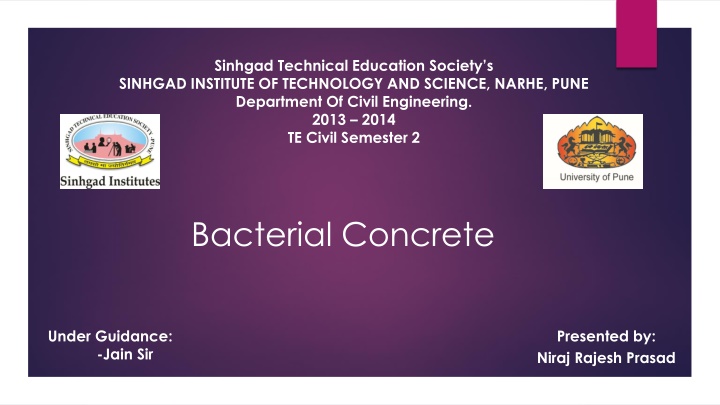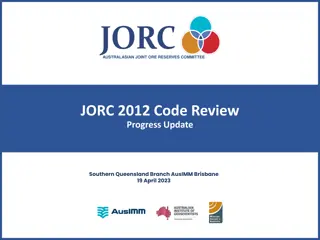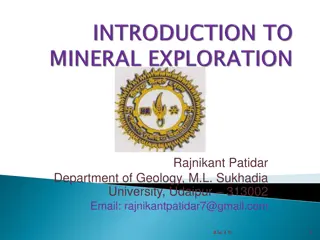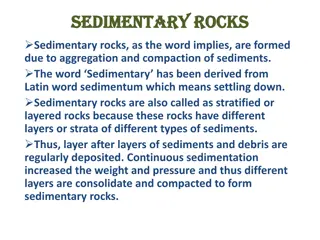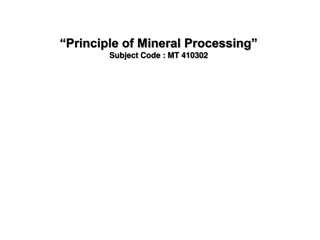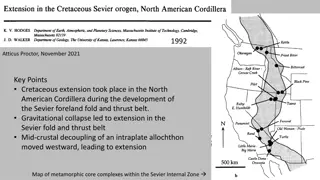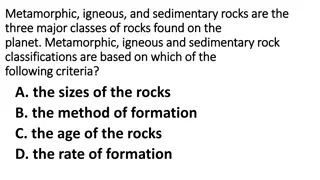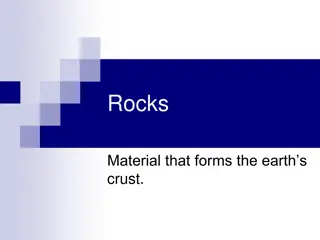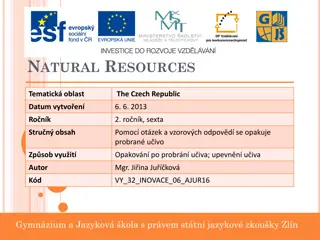Ore Deposits Formed by Metamorphic Processes
Metamorphic ore deposits result from isochemical equilibration and recrystallization of pre-existing materials due to high temperatures. Grain size increases, leading to the formation of various ore types such as skarn and contact-metasomatic deposits. Orogenic metamorphism at high temperatures and pressures also plays a key role in ore formation through regional metamorphism processes.
Download Presentation

Please find below an Image/Link to download the presentation.
The content on the website is provided AS IS for your information and personal use only. It may not be sold, licensed, or shared on other websites without obtaining consent from the author.If you encounter any issues during the download, it is possible that the publisher has removed the file from their server.
You are allowed to download the files provided on this website for personal or commercial use, subject to the condition that they are used lawfully. All files are the property of their respective owners.
The content on the website is provided AS IS for your information and personal use only. It may not be sold, licensed, or shared on other websites without obtaining consent from the author.
E N D
Presentation Transcript
Sinhgad Technical Education Societys SINHGAD INSTITUTE OF TECHNOLOGY AND SCIENCE, NARHE, PUNE Department Of Civil Engineering. 2013 2014 TE Civil Semester 2 Bacterial Concrete Under Guidance: -Jain Sir Presented by: Niraj Rajesh Prasad
2 Introduction Cracks In concrete Concretes are very susceptible to cracking which allows chemicals and water to enter . Cracking in the surface layer of concrete mainly reduces its durability. When micro cracks growth reaches the reinforcement corrosion occurs in the reinforcement. Synthetic polymers such as epoxy treatments are used for repair of concrete and they harm to the environment.
3 IS requirements for Serviceability R.C.C Clause 35.3.2 IS 456 (cracking) Cracking of concrete should not adversely affect durability & appearance of structure. Surface width of cracks should not exceed 0.3mm. Exposure to moisture the width is limited to 0.2mm. Our aim satisfy the serviceability requirement at entire life of structure.
4 Bacterial Concrete Use of these Bio mineralogy concepts in concrete defined a new material called Bacterial Concrete Bacillus subtilis mixed with concrete in dormant stage and they remain hibernated for 200 years. Gets activated when exposed to water or moisture. Precipitating calcite crystals through metabolism cycle the soluble nutrients are converted to insolubleCaCO3.
5 Characteristics Bacillus Subtilis Characteristics Bacillus Subtilis Shape, size, gram stain Long rods, 0.6-0.8 m in width and 2.0 to 3.0 m in length, gram positive Fermentation: Lactose Dextrose Sucrose No acid, no gas No acid, no gas Acid and gas H2S production Absent Indole production Present Colony morphology Irregular, dry, white, opaque colonies
6 Bacillus subtilus SEM image Bacillus subtilus Bacillus subtilus on agar plate
7 How does bacteria remediate cracks? Concrete is mixed with bacteria (bacillus subtilus) at dormant stage. To survive in this high alkaline environment for long durations form spores (highly resistant for 200 years ) withstanding during concrete mixing. A calcium lactate nutrient supplied along with bacteria in suspension helps in producing calcite crystals. The spores of the bacteria germinate on contact with the water and nutrients while cracks and get activated
8 Cont. As the bacteria feeds oxygen is consumed and the soluble calcium lactate is converted to insoluble limestone. The limestone solidifies on the cracked surface, thereby sealing it up. Tests all show that bacteria embedded concrete has lower water and chloride permeability by 88% Reaction: Ca 2+ + Cell --------> Cell- Ca 2+ Cell- Ca 2+ +CO3-----> Cell-CaCO 3 The crystals expand until the entire gap is filled.
9 Results by Research papers Strength Study Conventional Concrete Bio Concrete @ 28 days age M20 M30 M20 M30 Compressive Strength 28.18 37.14 32.74 41.06 Split Tensile Strength 3.26 4.51 3.93 5.13 Flexural Strength 4.68 5.11 6.11 6.73 Results in (Mpa) for Concrete and bacteria cell concentration 10^5/ml mixing water
10 Optimum Concentration of cell
11 SEM images for cell concentration
12 Advantages Perpetual and expected cracking that occurs in every concrete structure due to its brittle nature can be controlled. Repairs without a human work crew. Self-healing concrete also prevents the exposure of the internal reinforcements. It has made to extend the life span of a concrete structure of any size, shape. Material consumption reduced in form of cement.
13 Conclusion Microbial mineral precipitation resulting improve the overall behaviour of concrete. The greatest improvement in compressive strength occurs at cell concentrations of 10^5 cells/ml mixing water. The study result shows that 25% increase in 28 day compressive strength. Less permeability and corrosion resistance.
14 References Ramachandran S.K., Ramakrishnan V. and Bang S.S., Remediation of concrete using microorganisms, ACI Materials Journal 98(1), 3-9 (2001) Stocks-Fischer S., Galinat J.K., and Bang S.S., Microbiological precipitation of CaCO3. Soil Biology and Biochemistry, 31(11), 1563-1571 (1999) Tai C.Y. and Chen F.B., Polymorphism of CaCO3 precipitated in a constant-composition environment. AIChE Journal, 44(8), 1790-1798 (1998)
15 References S. SUNIL PRATAP REDDY International Journal of Earth Sciences and Engineering ISSN 0974-5904, Vol. 03, No. 01, February 2010, pp. 116- 124. V.Ramakrishnan, K.P.Ramesh and S.S.Bang, Bacterial Concrete Proceedings of SPIE Vol.4234 pp.168-176, Smart Materials. www.onlinelibrary.wiley.com/journal/10.1002/(ISSN)1547-5905
